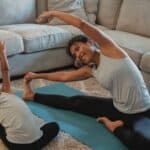
Effects of Detraining on Physical Capacity and Its Relationship With Depressive Symptoms, Quality of Life and Sedentary Behavior in Community-Dwelling Older Adults: A Longitudinal Study
May 30, 2024
Parent–Child Associations in Accelerometer-Measured Physical Activity and Sedentary Behaviour: The FAMIPASS Study
June 14, 2024A new study entitled, “Mapping sedentary behaviour (MAPS-B) in winter and spring using wearable sensors, indoor positioning systems, and diaries in older adults who are pre-frail and frail: A feasibility longitudinal study” was published in PLOS ONE. A summary and citation are included below.
ABSTRACT
Older adults who are frail are likely to be sedentary. Prior interventions to reduce sedentary time in older adults have not been effective as there is little research about the context of sedentary behaviour (posture, location, purpose, social environment). Moreover, there is limited evidence on feasible measures to assess context of sedentary behaviour in older adults. The aim of our study was to determine the feasibility of measuring context of sedentary behaviour in older adults with pre-frailty or frailty using a combination of objective and self-report measures. We defined “feasibility process” using recruitment (20 participants within two-months), retention (85%), and refusal (20%) rates and “feasibility resource” if the measures capture context and can be linked (e.g., sitting-kitchen-eating-alone) and are all participants willing to use the measures. Context was assessed using a wearable sensor to assess posture, a smart home monitoring system for location, and an electronic or hard-copy diary for purpose and social context over three days in winter and spring. We approached 80 potential individuals, and 58 expressed interest; of the 58 individuals, 37 did not enroll due to lack of interest or medical mistrust (64% refusal). We recruited 21 older adults (72±7.3 years, 13 females, 13 frail) within two months and experienced two dropouts due to medical mistrust or worsening health (90% retention). The wearable sensor, indoor positioning system, and electronic diary accurately captured one domain of context, but the hard copy was often not completed with enough detail, so it was challenging to link it to the other devices. Although not all participants were willing to use the wearable sensor, indoor positioning system, or electronic diary, we were able to triage the measures of those who did. The use of wearable sensors and electronic diaries may be a feasible method to assess context of sedentary behaviour, but more research is needed with device-based measures in diverse groups.
CITATION
Rodrigues, I.B., Tariq, S., Kouroukis, A., et al. (2024). Mapping sedentary behaviour (MAPS-B) in winter and spring using wearable sensors, indoor positioning systems, and diaries in older adults who are pre-frail and frail: A feasibility longitudinal study. Plos One, 1-15. https://doi.org/10.1371/journal.pone.0290197



